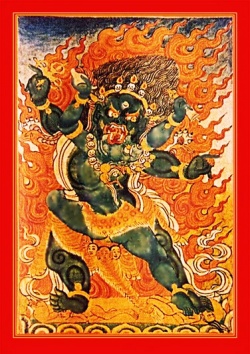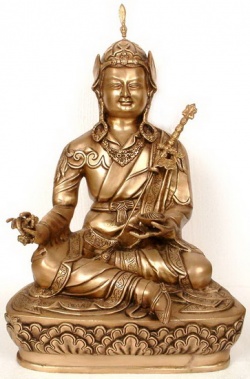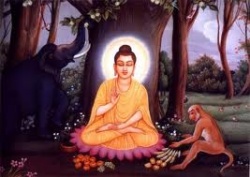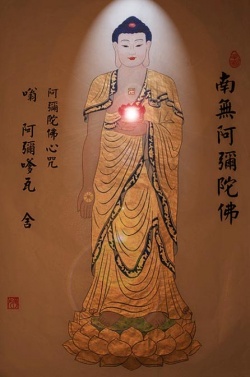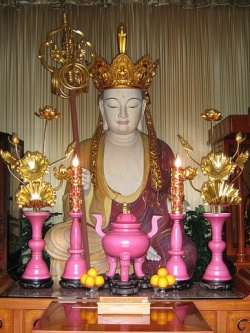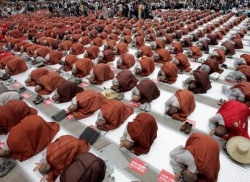The God Concept and How Buddhists Understand it
The God Concept
and
How Buddhists Understand it
Compiled by
Vira Avalokita, Sthera
The difficulty of discussing the subject of divinity is its definition. The Church has tried to define her concept of God in many different cultures of humankind; however, she has used old god names with new definitions attached. This practice is a common one used by translators of religious texts, i.e. the term god (gud, gott) has no relationship outside the Germanic countries or to the Hebrew meaning of YHWH. If we were able to go back in time, before Christianity came to the Germanic countries, we still could use the term God (gud, gott) and be understood, but in a different definition, Pagan .
The concept of divinity is not defined in Buddhism as it is in Christianity. This is not because Buddhists can not do it. It is that they have good reasons not to do so. If I should say, “God exists” this is an error. The reason being existence is dependent upon a cause, but God is causeless and outside the sense realm. Therefore a Buddhist does not define the Absolute because it is beyond words and concepts.
Why I am quoting Søren Kierkegaard, a Christian Humanist? Buddha was a humanist and his arguments and examples were very humanistic and timeless. The Humanistic Thought of Søren Kierkegaard is shown in, Søren Kierkegaards Samlede Væker,I-XIV(Copenhagen, 1901-1906). This is the first collected Danish edition; all references have been noted in reference to this edition. Søren Kierkegaard is one of many Christian Humanist in Modern times.
Kierkegaad gives an understanding as how to define the term God:
- All our language about God is, naturally, human language. However much we try precluding misunderstanding by in turn revoking what we say–if we do not wish to be completely silent, we are obliged to use human criteria when we, as human beings, speak about God. What, then, is true human greatness? Surely it is greatness of heart. . . .When we, human beings as we are, want to form a conception of God’s greatness, we must think about true human greatness. (Søren Kierkegaard,Christian Discourses, 1848, X 360).
Kierkegaard uses the same logic as in Buddhism in his article Despair is the Sickness unto Death, 1849, here is an example:
- A human being is spirit. But what is spirit? Spirit is the self. But what is the self? The self is a relation that relates itself to itself or is the relation’s relating itself in the relation; the self is not the relation but is the relation’s relating itself to itself. A human being is a synthesis of the infinite and the finite, of the temporal and the eternal, of freedom and necessity, in short, a synthesis. A synthesis is a relation between two. Considered in this way, a human being is still not a self (XI 127).
It is difficult to come to any definition of a term from one culture to another especially when it is in another language. The process takes understanding of not only of the translator’s own language, but also of the other person’s culture and how their language is connived. Definitions are best defined through experience than any linguistic form. An example of this is the taste of sugar. I can say anything about its sweetness; however, once it is tasted the person has the definition that is beyond words and concepts. This is how Buddhism understands relative and absolute realities. Hebrew language terms and discussions are taken from the Online Jewish Encyclopedia.
The Hebrew letters יהוה express the idea of God in four letters and is called a Tetragrammaton, YHWH or YHVH in Roman script. The tetragrammaton derives from the prefix tetra- (four) and gramma (letter) and it is first encountered in Gen.2:4.
In appearance, YHWH is an archaic third person singular imperfect of the verb to be, meaning, therefore, He is. This explanation agrees with the meaning of the name given in Exodus 3:14, where God is represented as speaking, and hence as using the first person — I am. It stems from the Hebrew conception of monotheism that God exists by himself for himself, and is the uncreated Creator who is independent of any concept, force, or entity; therefore I am that I am. Thus YHWH is not a concept created by the human mind, but a name revealed to the Hebrews by Himself. This is the difference between Buddhism and the Hebrew Religion anything that is in reference to YHWH is revealed by YHWH.
In the Hebrew Language God is called by the following names:
- 1. Adonai, Hebrew for Lord (אֲדֹנָי) or A-D-N. Formally, this is plural (my Lords), but the plural is usually construed as a pluralis excellentiae, a respectful plural, and not a true grammatical plural.
- 2. Ehyeh asher ehye ( אהיה אשר אהיה) is the sole response given to Moses when he asks for God's name (Exodus 3:14
- 3. El (אל) appears Ugaritic, Phoenician and other 2nd and 1st millennium BCE texts both as generic "god" and as the head of the divine pantheon. In the El appears very occasionally alone (e.g. Genesis 33:20, el elohe yisrael, El the god of Israel, and Genesis 46:3, ha'el elohe akiba, El the god of your fathers), but usually with some epithet or attribute attached (e.g. El Elyon, Most High El, El Shaddai, "El of Shaddai", El `Olam Everlasting El, El Hai, Living El, El Ro'i El of Seeing, and El Gibbor El of Strength), in which cases it can be understood as the generic "god".
- a) In theophoric names such as Gabriel (Strength of God), Michael (Who is like God?), Raphael (God's medicine), Ariel (God's lion), Daniel (God's Judgment), Israel (one who has struggled with God), Immanuel (God is with us), and Ishmael (God Hears/God Listens) it usually interpreted and translated as "God", but it is not clear whether these "el"s refer to deity in general or to the god El in particular.
- 4. Elah (אֵלָה), (plural "elim") is the Aramaic word for awesome. The origin of the word is uncertain and it may be related to a root word, meaning “fear” or “reverence.” Elah is found in the Tanakh in the books of Ezra, Daniel, and Jeremiah (Jer 10:11, the only verse in the entire book written in Aramaic.) Elah is used to describe both Pagan gods and the one true God.
- 5. Elohim (אלהים). Despite the -im ending common to many plural nouns in Hebrew, the word Elohim, when referring to God is grammatically singular, and takes a singular verb in the Hebrew Bible. The word is identical to the usual plural of el meaning gods or magistrates, and is cognate to the 'lhm found in Ugaritic, where it is used for the pantheon of Canaanite Gods, the children of El and conventionally vocalized as "Elohim" although the original Ugaritic vowels are unknown. When the Hebrew Bible uses elohim not in reference to God, it is plural (for example, Exodus 20:3).
- 6. `Elyon (עליון) occurs in combination with El, YHWH or Elohim, and also alone. It appears chiefly in poetic and later Biblical passages. The Modern Hebrew adjective "`Elyon" means "supreme" (as in "Supreme Court") or Most High. El Elyon has been traditionally translated into English as 'God Most High'. The Phoenicians used what appears to be a similar name for God, Έλιον. It is cognate to the Arabic `Aliyy.
- 7. Shaddai (שדד) according to Exodus 6:2, 3, is the name by which God was known to Abraham, Isaac, and Jacob. The name Shaddai (שַׁדַּי) is used as a name of God later in the Book of Job.
- a) Shaddai was a late Bronze Age Amorite city on the banks of the Euphrates River, in northern Syria. The site of its ruinmound is called Tel eth-Thadyen: "Thadyen" being the modern Arabic rendering of the original West Semitic "Shaddai". It has been conjectured that El Shaddai was therefore the "god of Shaddai" and associated in tradition with Abraham, and the inclusion of the Abraham stories into the Hebrew Bible may have brought the northern name with them.
- b) In the vision of Balaam recorded in the Book of Numbers 24:4 and 16, the vision comes from Shaddai along with El. In the fragmentary inscriptions at Deir Alla, though Shaddai is not, or not fully present, shaddayin appear, less figurations of Shaddai. These have been tentatively identified with the ŝedim of Deuteronomy 34:17 and Psalm 106:37-38, who are Canaanite deities.
- c) In the Septuagint and other early translations Shaddai was translated with words meaning Almighty. The root word "shadad" (שדד) means "to overpower" or "to destroy". This would give Shaddai the meaning of destroyer as one of the aspects of God. This is interesting since a Buddhist Reality does not destroy. This epithet was one of the reasons for the rejection of the Bharman god, Śiva.
- d) It is also given a Midrashic interpretation as an acronym standing for "Guardian of the Doors of Israel" (שׁוֹמֶר דְלָתוֹת יִשְׂרָאֶל). This acronym, which is commonly found as carvings or writings upon the mezuzah (a vessel which houses a scroll of parchment with Biblical text written on it) that is situated upon all the door frames in a home or establishment.
- e) The Talmud explains it this way, but says that "Shaddai" stands for "Mi she'Amar Dai L'olamo" - He who said 'Enough' to His world. When God was creating the world, He stopped the process at a certain point, holding back creation from reaching its full completion, and thus the name embodies God's power to stop creation. This explanation Buddhism would reject since it would place the Reality responsible for error and that Reality would be the cause of all human sufferings.
- f) It is often paraphrased in English translations as "Almighty" although this is an interpretive element. The name then refers to the pre-Mosaic patriarchal understanding of deity as God who is sufficient. God is sufficient, that is, to supply all of one's needs, and therefore by derivation "almighty".
- g) It may also be understood as an allusion to the singularity of deity "El" as opposed to "Elohim" plural being sufficient or enough for the early patriarchs of Judaism. To this was latter added the Mosaic conception of YHWH as God who is sufficient in Himself, that is, a self-determined eternal Being qua Being, for whom limited descriptive names cannot apply. This may have been the probable intent of "eyeh asher eyeh" which is by extension applied to YHWH (a likely anagram for the three states of Being past, present and future conjoined with the conjunctive letter vav), cf. Exodus 3:13-15.
- 8. Shalom ("Peace"; שלום) The Talmud says "the name of God is 'Peace'" (Pereq ha-Shalom, Shab. 10b), (Judges 6:24); consequently, one is not permitted to greet another with the word shalom in unholy places such as a bathroom (Talmud, Shabbat, 10b). The name Shlomo, "His peace" (from shalom, Solomon, שלומו), refers to the God of Peace.
- 9. Shekhinah (Hebrew: שכינה) is the presence or manifestation of God which has descended to dwell among humanity. The later rabbis used the word when speaking of God dwelling either in the Tabernacle or amongst the people of Israel. The root of the word means "dwelling". One of the principal names of God, it is the only one that is of the feminine gender in Hebrew grammar. Some believe that this was the name of a female counterpart of God, but this is unlikely as the name is always mentioned in conjunction an article (e.g.: "the Shekhina descended and dwelt among them" or "He removed Himself and His Shekhina from their midst"). This kind of usage does not occur in Semitic languages in conjunction with proper names.
- 10. The name tzevaot or sabaoth (hosts" or "armies, צבאות) The name YHWH and the title Elohim frequently occur with this word as YHWH Elohe Tzevaot ("YHWH God of Hosts"), Elohe Tzevaot (God of Hosts), Adonai YHWH Tzevaot ("Lord YHWH of Hosts") and, most frequently, YHWH Tzevaot ("YHWH of Hosts").
- a) This compound name occurs chiefly in the prophetic literature and does not appear at all in the Torah, Joshua or Judges. The original meaning of tzevaot may be found in 1 Samuel17:45, where it is interpreted as denoting "the God of the armies of Israel". The word, in this special use is used to designate the heavenly host, while otherwise it always means armies or hosts of men, as, for example, in Exodus6:26, 7:4, 12:41. In Buddhism this term would not be applied to the Reality since there is not reason for an army either heavenly or earthly.
- b) The Latin spelling Sabaoth combined with the golden vines over the door on the Herodian Temple (built by the Idumean Herod the Great) led to false-identification by Romans with the god Sabazius.
- 11. The Place" (המקום). Used in the traditional expression of condolence; המקום ינחם אתכם בתוך שאר אבלי ציון וירושלים HaMakom yenachem etchem betoch shs’ar aveilei Tziyon V’Yerushalayim — "The Place will comfort you (pl.) among the mourners of Zion and Jerusalem."
Laws of writing divine names
According to Jewish tradition, the sacredness of the divine names must be recognized by the professional scribe who writes the Scriptures, or the chapters for the tefillin and the mezuzah. Before transcribing any of the divine names he prepares mentally to sanctify them. Once he begins a name he does not stop until it is finished, and he must not be interrupted while writing it, even to greet a king. If an error is made in writing it, it may not be erased, but a line must be drawn round it to show that it is canceled, and the whole page must be put in a genizah (burial place for scripture) and a new page begun. Note: This is not a common practice with Dharma Texts, thus showing a pointed difference, the words of the Tathagata are only human and not divine.
The Tradition of Seven Divine Names
According to Jewish tradition, the number of divine names that require the scribe's special care is seven: El, Elohim, Adonai, YHWH', Ehyeh-Asher-Ehyeh, Shaddai, and Tzevaot. However, Rabbi Jose considered Tzevaot a common name (Soferim 4:1; Yer. R. H. 1:1; Ab. R. N. 34). Rabbi Ishmael held that even Elohim is common (Sanh. 66a). All other names, such as Merciful, Gracious, and Faithful, merely represent attributes that are common also to human beings and not just to God, (Sheb. 35a).
The Hebraic Tradition is a Theocracy via Priests of the Temple in Jerusalem and they were the power brokers. The High Priest was the only one who could say the Sacred Name YHWH and only once a year on Yon Kippur and every priest that was in attendance lay prostrate on the ground as he spoke YHWH. YHWH was a power word that showed Authority of GOD. This concept will be used by translators of both Hebrew and Christian translations of the Sacred Scriptures.
Hebrew Christians went to the Greek and Roman World in Asia Minor. This move would break all its organic ties with the original Hebrew Society and complete a Hellenistic transformation that had started before the advent of Christ. This would be realized in its fullest when the European Crusaders of the Middle Ages were not able to recognize the existing Hebraic Christians and destroyed them along with the Jews and Muslims when they took the city of Jerusalem.
The original Church had a Hebrew culture, but when it evangelized the Greek and Roman World there was a great adaptation to the new Society, the greatest was in language. The traditional language of the Hebrew Church was translated into new forms, and Pagan terms were used with new definitions, i.e. Dominus Deus (Lord God). This was an exclusive title of the Emperor of the Roman Empire and was now applied to YHWH >Dominus Iesus, who is the true and only King. I should note that on the sign placed on Christ’s cross by Pontius Pilate read Rex Iudacus. Why then not Dominus Deus? Simple, it was a power word in Roman Culture, the Emperor’s exclusive title.
The translation of YHWH>θεοη into the Latin Dominus Deus, was a flash point for the Romans. No one dared to use it, but the Christians did, but why? Romans held that law derives its force from being enacted by a proper authority; this authority to make law was called majestas, or sovereign power, and they attributed it to the emperor, Dominus Deus.
The Roman Empire was a world state; there was no other state but it; no living human being except the emperor was sovereign; no one anywhere on earth was his equal. Between gods and human beings, in the Pagan view, there was no clear distinction. Some gods behaved very humanly, and some human creatures were more like gods than others. The emperor was held to be veritably a god. A cult of Caesar was established, regarded as necessary to maintain the state, which was the world itself. All this Christians firmly refused to accept. It was because they would not use the highest worship (lauds) for Caesar that the Roman officials regarded them as social incendiaries who must be persecuted and stamped out. The Buddhist Sangha has the same regard for rulers as Roman Christians, i.e. the Sangha never salutes national flags, stands for anthems or for kings, presidents and the like; they regard the Sangha at a higher level than a temporal government.
What divided Pagans from Christians was not monotheism, since many Pagans tend to be monotheist, as Pagans’ essential held to conservatism. It was that the Christian movement offered a radical alternative to Roman society. The Roman senator Tacitus complained:
- The first thing they do when they get hold of people is to teach them to despise their gods, neglect their cities, and hate their families; everywhere that we know as piety they neglect. (Tacitus, Histories 5.5).
St. Tatian declared himself free from all worldly affiliations in Roman Society and openly defied Pagan rulers including the Emperior:
- I reject your legislation, along with your entire system of government Only allegiance to the one true God can put an end to the slavery that is in the world, and restore us from many rulers, and then from ten thousand tyrants (Address to the Greeks, 23)
It was the Christians who supported Emperor Constantine in the fourth century, who had a vision of a Cross in the sky and the Emperor in 312 C.E. converted to Christianity. By the fifth century the entire Roman world was formally Christian; no other religion was officially tolerated; and the deepest thinkers were Christians who combined Christian beliefs with the now thousand –year- old tradition of Greco-Roman thought, philosophy, and social institutions.
On an intellectual level Christianity also marked a revolution. It was Christianity, not rational philosophy that dispelled the evil gods and goddesses; the bloody sacrifices and self-immolation; or the frantic resort to magic, fortune-telling, and divination. The Christians taught that there was only one God. The Pagan conception of local, tribal, or national gods disappeared. For all the world there was only one plan of Salvation and One Providence, and all human beings took their origin from one source. The idea of the world as one thing, a ‘universe,” was thus affirmed with a new depth of meaning. The very intolerance of Christianity, which was new to the ancient world, came from this sense of human unity, in which it was thought that all people should have, and deserve to have the one true and saving religion.
The early Greek fathers made extensive use of reason and philosophy in their attempt to define Christianity to the Romans and Greeks.
St. Justin Martyr influenced by Platonism, emphasized God as:
- 1. Ineffability, (in-not+effabilis-utterable)
- 2. Omnipotence, (omnis-all+poten-able)
- 3. Impassibility, (im- no+passibilis-emotions)
St. Athenagoras and St. Theophilus focused on God's:
- 1. Simplicity, (simplicitas)
- 2. Indivisibility, (individualitas)
- 3. Universal providence. (provincia universalis)
St. Irenaeus developed his doctrine of God in reaction against the Gnostics, and thus emphasized of God:
- 1. Self-sufficiency, (sufficiens)
- 2. Perfection (perfectio)
The Council of Nicea, (325 C.E.), the chief divine attributes of God were already in place and confirmed by the Council as follows:
- 1 Eternity, (aeturnus)
- 2. Immutability, (immutabilis)
- 3. Omniscience, (omni-all+sciens-knowing)
- 4. Omnipotence, (omni-all+potentia-able)
The western part of the Roman Empire was devastated in 330 C.E by the moving of the seat of the Empire to Constantinople, the old Greek city of Byzantium. The Christian Church was the only organized institution left in the West, and it reached over the whole West with a new type of a religious institution, this was the Roman Catholic Church.
As early as 340 C.E., the Church sent from Rome missionaries to convert what was to become Europe. St. Ulfilas translated the Bible into a Germanic language and converted the Goths. About 496 C.E. Clovis, the King of the Franks was converted. A hundred years latter, in 597 C.E. Southeast England was converted by St. Augustine of Canterbury, a missionary dispatched from Rome. By the end of 732 C.E. the peoples of Western Europe started to expand their emerging Latin Christian culture.
How the Catholic Missionaries explained the doctrines of the Roman Church in those early times is not always well understood for it transformed a Celtic religion to a complex Christian one. The vast majorities of believers were unlearned and simply people keeping both traditions, i.e. Gud: a word that is common to all Germanic Languages, in which it has numerous derivatives, but not identified outside of Germanic countries. It was originally a neuter word, and generally in the plural to non Christian deities and elevated to the Christian sense upon the conversion of the Germanic peoples.
The Church maintained her Theology and rituals in Latin thus preserving the teaching of Christ in a language that was more developed than the Germanic ones. The rise of society in Europe, the centers of monastic houses, the first universities in the 12th through 15th Centuries, great movements in Theology and the return of Greek and Roman learning that caused an increase in natural sciences, mathematics and logical philosophy. This started a change that would and still is changing of our world everyday.
The history of the Latin Church is a history of missions from the early days to the present. If it was not for the foundations that were established from Rome in the early 340 C.E. there would be no Modern Western World. The missionaries of today still come from Roman Catholic or Protestant Churches of the West.
A belief in a religious mission of European civilization led to the establishment of European churches, schools, and hospitals under auspices of the Roman and Protestant Churches in much of Asia. Through these missions Europeans would experience an interaction with ancient non-European societies. Europeans felt that they were superior and had a burden to bring civilization to heathen and that would in fact destroy far older civilizations. They would also take a belief that Asian religions were the works of the Devil. This view was only altered by the Roman Catholic Church, Vatican II, Nostra aetate, 1965, and it looked at non-Christian beliefs as having some value. The Church also looked at herself not as a civilizer of cultures, but to proclaim of the Christian religion everywhere (Pope Pius XI, 1939); however, all Protestant Churches would retain the view that all non Christian religions were evil.
This encounter of Europeans with Asians would create interest in Buddhism in both Europe and American. This interest was from the general public, a new middle class with money and time for leisure. This class of persons ever since the 18th Century started to want everything Chinese, then in the 19th Century they wanted everything Japanese and religiously they were intrigued, especially those who looked for links to the Mysterious East for their Christian beginnings.
In the 19th Century there was held a World Parliament of Religions and there were speakers for the first time from the Asian Religions, who spoke in English, such as an Buddhist Anagarika from Ceylon, a Zen Roshi from Japan and a Swami from India. This event and others like it created an interest in Zen Buddhism in particular and Europeans began asking questions and establishing groups such as the Pali Text Society in England to study and understand Buddhism and Europeans entered the Buddhist Sangha.
The conceptions of God differ widely in different systems of religions and metaphysics; but they fall, in general, under two heads: Pantheism and Theism. Theism is thought to be most fully developed in Christianity and in which God is regarded as a personal moral being, distinct from the universe, of which he is the author and ruler.
The name God, as Descartes understood it as substance infinite (eternal, immutable) independent, all-knowing, all-powerful, and by which I myself, and every other thing that exists, if any such there be, were created (Descartes, Meditations, III).
In Spinoza’s philosophy, he begins with the idea of God as the substance of all things, as the infiniteness of finitude and difference (E. Caird, Philos. of Kant p.47). The Spinoza’s philosophy here conforms to a Buddhistic view.
One conversation in Buddhism is concerning the Dharmakaya and it is in every Buddhist School discussed but not defined. The general explanations that are given below are what Dharmakaya is thought to be like:
- 1. Permanent,
- 2. Undifferentiated,
- 3. Comprehending Truth,
- 5. It is Primary Truth.
- 6. The Prajnaparamitas as produced by the Dharma, the highest being;
- 7. Prajna, the highest knowledge.
- 8. Daijogisho says the beginningless body of Being itself.
- 9. Butsujikyo, Tathagata’s self–nature, permanent and unchanging,
- 10. The real nature of every Buddha and every being.
- 11. The Madhyamika Reality which cannot be expressed in words.
- 12. The Yogacharas the Absolute.
Dr. D. T. Suzuki writes as follows:
- The Dharmakaya is a soul, willing and knowing being, one that is will and intelligence, thought and action, not a metaphysical principle like Suchness, but it is a living spirit that manifests in nature as well as in thought. . . an absolute perfect intelligence. . .an inexhaustible fountain-head of love and compassion.(D.T. Suzuki: Outlines of Mahayana Bud-dhism, pp. 222-223.)
Matsunami Yoshihiro, Sensei writes:
- Vairocana is the principle or essence of the universe and all phenomena are embraced in him; Vairocana is beginningless and endless ultimate reality. (Matsunami Yoshihiro, sensei)
Comments as noted above are not definitions; God is not defined, but is found in the Practice, and experienced by the individual who practices. Reality is a term can not be defined in Buddhism as it is in Western Monotheistic Religions. The main reason is there is no test to prove that there is a god expect by the experience of the person viewing Reality> God >for himself. This is through Mystic Intuition, i.e. Faith alone. In Buddhism this is a gift to all freely given to be interpreted by the student alone. No church, institution or school can understand this experience, only the person can and if he or she equates it with non-theism or theism or their own understanding it is his or her choice alone. It is not how you say what you believe that is important, but what you think, do and say is most important in Buddhism. Creeds give no assurance that an individual or an institution will be good and kind.
Why does Buddhism not make statements like a creed? The reason is Authority. Buddhism has no authority to do so. The Buddha had no authority to do what he did, he was not an apostle. I will quote Kiekegaard on this point:
- The genius (Buddha) is what he is by himself, that is, by what he is in himself; an apostle is what he is by his divine authority (Two Ethical Religious Essays, 1849 XI, 97)
Institutions make statements, but a Tathagata (the thinker) does not. Why? Kiekegaard answers:
- The Poet, the thinker (Tathagata), on the other hand, does not have any authority, not even within this relativity; his utterance is evaluated purely esthetically or philosophically by evaluating the content and form. (ibid. XI, 99).
- . . . Let us take someone who wants to rack his brains profoundly on the question of immortality–will he not be justified in denying that the direct statement is a profound answer to the question? What Plato says about immortality is actually profound, attained by profound cogitating; but then poor Plato does not have any authority. (ibid. XI 105).
Then we have to understand what is meant by an arahant (genius) and Kiekegaard again can help us in his statement:
- It is different with a genius (arahant). He has only an immanent teleology, he develops himself, and as he develops himself he plans this, his self-development (samyaksambuddhaya), as his activity. He surely acquires significance, perhaps even great significance, but he is not himself teleologically positioned in relation to the world and others. A genius (arahant) lives within himself, and he can humorously live in secluded self-satisfaction without therefore nullifying his talent if only, with earnestly and diligently, following his own genius. The genius (arahant) is by no means therefore inactive . . . works more that ten businessmen . . . accomplishes a great deal . . . but each of his accomplishments has no τέλος [end, goal] outside. This is simultaneously the humanity of the genius (arahant) and his pride: the humanity in his not defining himself teleologically in relation to any other person, as if there were anyone who stood in need of him; the pride consists in his relating himself immanently to himself . . . does not care at all to know whether anyone listens to it or not. . . No genius (arahant) has an in order to; the apostle absolutely paradoxically has an in order to. (ibid. XI 108-109)
So here we have it, Buddhism needs no creeds, no definitions out side the individual. However, Buddhism is pleased with definitions, like the one below, explaining the belief of the Catholic Church in simple language as required by Vatican II. So here is a definition, a simple creed. Buddhism agrees with the First Statement for the Reality is personal; the Second Statement, Buddhism also agrees with the right of the individual to explain the experience he or she has had with the Reality and as he or she has experienced it, and the Third Statement, Buddhism rejoices that the person has come in contact with the Reality by an experience of faith and trust.
The Experience of the Catholic Faith in Simple Language
- 1. While the inner Being of God always remains unknown and unapproachable, God has manifested Himself to us;
- 2. The Church has experienced Him as Father, Son, and Holy Spirit. The Doctrine of the Holy Trinity, which is central to the Catholic Faith, is not a result of pious speculation, but the over whelming experience of God.
- 3. The doctrine affirms that there is only One God in whom there are three distinct Persons. In other words, when we encounter either the Father, the Son, or the Holy Spirit, we are truly experiencing contact with One God.

